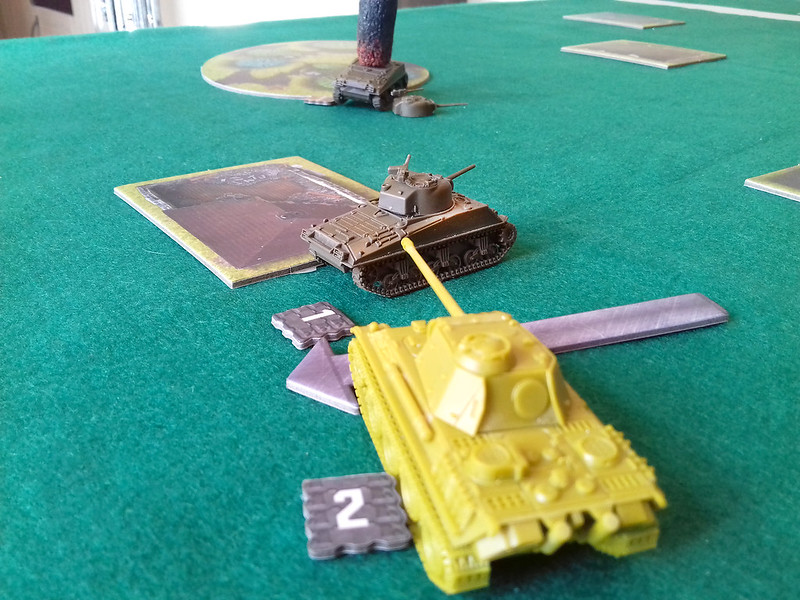However, for many war-gamers, part of the enjoyment of the hobby is the crafting of scenery and accessories and making a little historically accurate piece of Waterloo or Normandy or whatever your choice of battle is that you wish to recreate. So, much crafting ensues!
Just how far down the rabbit hole of 'authenticity' you want to go is up to the individual and, certainly, I have seen some amazing examples of realistic looking and beautifully landscaped battle tables...
 |
| An wonderful example of some beautifully constructed and realistic landscape! |
 |
| A magnificently atmospheric recreation of Normandy for some war gaming, the town painstakingly crafted. |
The Galeforce 9 TANKS! Battlefield Philosophy...
One of the things I liked about GF9T was that you could jump straight in with everything you needed by buying one of their starter sets. In the box you got all the bits and pieces you needed to start playing the game immediately, including some tanks and some flat 'scenery' with which you could make your battlefield...
 |
| My very first game of GF9T - straight out the box, with the 'scenery' provided and the tanks aren't even painted yet! LOL |
However, I eventually found that ALL flat scenery had some disadvantages. As you can see from the above picture of my very first game the set-up leaves something to be desired by way of atmosphere - you'd have to really stretch your imagination to feel immersed in the idea that this was supposed to be France in 1944! 😂
Additionally, as I have mentioned in previous posts, GF9T's base mechanic is tank combat using 'line of sight' - in other words, if you can see it you can shoot it. Therefore, the intensive to add some proper 3D scenery becomes desirable, if only to help resolve instances of 'you can't see me from there' disagreements (which are a little more problematic when using flat scenery).
 |
| The most important view in GF9T...Line of sight to your enemy. But is that flat 'cottage' tile blocking your view? Hhhhhmmmm... |
Terrain building is an art in itself and once you start down that slippery slope you have to be very careful to balance your original intent - just to play a quick hour long game - against a project that could then blossom into an obsessive modelling project that could take up weeks of your time!!!
While full-blown wargamers who play games with rules that mean that their games could stretch into days long play (if not longer if they are playing a campaign) might want to have a immerse battlefield because they are spending so much time playing on it, I - on the other hand - just want a quick fix of blast 'em up fun and action.
Horse's for Courses...
So the driving force behind my need for scenery is simple, practical and is based on fun rather than on what is strictly factual. I'm make some effort to make my board look pretty - but I'm not going to spend enormous amounts of time planning and making a replica battlefield when I already have three or four (or more) ideas about the next battles I'd like to play banging about in my head.
I'm looking at scenery that can be quickly laid down to create a general sense of landscape but which can just as quickly be dissembled and packed away.
This attitude formed the fundamental requirements for how complex my scenery needed to be. It needed to be quick and easy to construct - I might only use it a couple of times so no weird and niche items that will just end up as draw fodder - and they should be rather generic and so re-usable.
Your requirements may differ - it's a sort of sliding scale.
The basis of any tabletop battlefield is the battlefield itself - by this I mean the base on which you place any other scenic items. And for me, my ubiquitous green felt cloth (other colours are available) is the ideal multi-national, all-encompassing 'moderate climate' theatre of war. That said, I have of late been tempted by off-the-peg battle mats that have texture patterns printed on them...
 |
| Might one of these printed battle mats finally replace my trusty felt cloth as my go to battlefield? This is a Deepcut Studio 'Grass Plains' mat. |
KISS - Keep it Simple Stupid!
...And having established my preference for a simpler and more 'stylised' approach to making my battlefield everything else sort of just falls into place...
I have already desired that I really like the quick build paper-craft buildings I have been making, they fit right into my 'cheep and cheerful' ideal. Because of this pared-down 'psudo-realism' all my other scenic items sort of need to follow suit. They have to be...
- Cheap
- Easy and quick to make
- Preferably modular and usable in different ways
- Unfussy and simple (preferably not multipart things I have to assemble)
- Portable and kinda disposable
- East to store
Because of my new love affair with papercraft models I am keen to carry this on for different parts of my terrain, such as rivers, roads, etc. In this way I can have a sort of unified aesthetic, so I'm now on the hunt for different pieces I can collect to make a 'battlefield kit'...
And so the search for papercraft terrain begins!



No comments:
Post a Comment